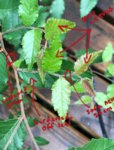I’ve mentioned “hardening off” before. When I’ve discussed it, I’m referring to the process of lignification - new growth is very soft and pliable. It’s easily damaged when you work on it. As the growth matures, lignin is deposited on the cell walls. Visually, both the leaf and the stem will change color. Here in Houston, that usually takes about 4-6 weeks after the shoots appear. Here’s an example on a water elm.
View attachment 193076
The new leaves are reddish green when they first appear, then turn pale green. When they’re hardened off, they turn dark green. The new stems are reddish in color and furry. They darken to a reddish brown and develop spots as the bark begins to mature.
As the new growth continues to mature, mature bark will develop and the branch will get very brittle. If I attempt to wire the soft growth too soon, it simply dies - I’m certain that if I attempted to wire the shoots in the picture above, they would just blacken and die. I think it’s because the lignin protects the vascular tissue and, without it, the vascular tissue of the new shoots is easily damaged. If I wait too long (until the dormant season, for example), development of the woody tissue is complete and the branch becomes hard and brittle. It’s difficult to add much movement without breaking the branch. Also, it’s inefficient. If you wait until the dormant season to wire, you can only wire your tree once per year. If you do it during the season, you can wire the new growth multiple times.
So for me, this is an important concept for trees IN DEVELOPMENT when I’m trying to build basic branch structure. I let the growth extend until it’s hardened off, then I wire and prune. For me, hardening off is a useful concept to describe the earliest point in the lignification process when the new growth is safe to wire. In response, a new flush of growth will emerge and when it hardens off I can work it again. Depending on the species, I can usually work a tree 3 times or so during the growing season. IN REFINEMENT, things are different and the concept of hardening off is less useful to explain techniques like pinching and partial outer canopy defoliation. I tend to focus on development techniques because A) that’s the stage in which most of my trees are in, so learning these techniques is important to me, B) that’s the stage that nearly every broadleaf tree I see posted on this forum is in, so I think that’s what’s useful for other people to hear, C) refinement techniques are widely available, but there’s almost nothing written about development techniques.
Anyway, that’s my 2 cents. How do you decide when the spring shoots are strong enough to wire?
S


